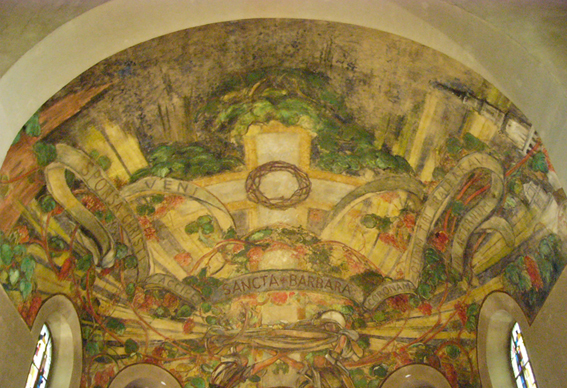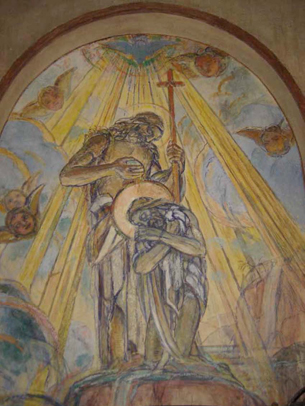| News |
<
|
15 September 2012
|
>
|
|
The Church of Saint Barbara at Wittenheim (Alsace) The Decorative Work of George Desvallières Brilliantly Restored 
The Inauguration Ceremony The inauguration of the restored mural paintings by George Desvallières on the choir vault and in the baptistry chapel at the Church of Saint Barbara in Wittenheim took place on the 15th of September 2012. At the inauguration ceremony, Monsieur Antoine Homé, the mayor of Wittenheim, paid tribute to the work of the restorers Monsieur et Madame Pequignot. He underlined the vast extent of the combined efforts contributed by the Municipality of Wittenheim, the Industrial Council, the Local District Council, and the Parish Priest that had enabled the restoration to be carried out of a masterpiece whose importance was unique in Alsace. Monsieur Homé also emphasized that this second phase of the restoration, the first phase having been that of the Way of the Cross completed in 2010, had in particular been made possible thanks to the support of the Direction Régionale des Affaires Culturelles. The Parish Priest, Monsieur Philippe Burgy, underlined, for his part, the spiritual dimension of this unique ensemble by Desvallières: “Restoring a fresco was not simply decorating a wall, or repairing a beautiful work of art: it was a means of articulating the spoken word and the image.” This inauguration coincided with the centenary of the creation of the Cité Sainte Barbe, directly linked with the exploitation of the potassium mine nearby which ensured the prosperity of the town until 1970 and whose director, Monsieur de Retz, had commissioned this work from George Desvallières in 1928. That explained the representation of the Church of Czestochowa in the Triumph of Saint Barbara, in honour of the contingent of Polish workers who had toiled in the mine.
Géraldine Veyrat 
An exemplary Restoration The Paintings of George Desvallières in the Church of Saint Barbara at Wittenheim. The Triumph of Saint Barbara, The Choir Vault. The Baptism of Christ, The Baptistry. The report on the restoration (April-May 2012) of the choir vault and the baptistry carried out by Francine and François Péquinot with Catherine Hulse bears witness to the seriousness and professionalism of their work. We publish here a summary of the report inasmuch as it seemed to us to be most interesting, and we reiterate our gratitude to the authors who sent it to us. Following a brief historical account of the two works restored in the spring of this year, a detailed description is given of a particularly interesting element brought to their attention by Catherine de Bayser at their meeting on completing their remarkable restoration of the Way of the Cross. As opposed to the painting that covers the walls on each side of the nave, the paintings of the vault and of the baptistry are not done on canvas, but are executed directly on the walls themselves (1). To this effect Desvallières exceptionally used the product “Stic B”, created in the twenties and most frequently employed by his friend Maurice Denis. This is a composite matter, a mixture of linseed oil and phenolic resin to which is added a particular load (lime, quartz, gypsum and pigments) giving “a range of lusterless lacquer paints ready for use” (2). This product also lessens the negative effect of paint containing lead that intoxicates the artists similarly to painters of buildings. A study of the paintings prior to restoration indicated that the entire work was covered by a thick layer of dust and by heavy general soilure. Numerous fissures of varied depth were observed, as well as the restoration work by Robert Gall in 1946 that introduced cements different from the original mortar, and heavily yellowed or browned varnishes. In order to carry out the restoration work, two sets of scaffolding were erected: in the choir and in the baptistry. Photographic views were taken, and a survey made of all alterations prior to commencing the restoration. Before proceeding to cleaning with a damp sponge, it proved necessary remove the dust with a long-distance vacuum-cleaner, and to use acetone in order to cleanse certain areas that were varnished and yellowed. In order to repair the fissures, the team carried out a further cleansing operation before stopping them up with the appropriate filling. When they had finished the 120 square meter vault, they proceeded in the same fashion with the paintings in the baptistry. Mention should also be made of the extremely successful restoration of the cover of the baptismal fonts that were previously rusty and covered with dust. The transmission of archives (3), contemporaneous with the beginning of the 1929 project and with the 1946 retouching by Robert Gall, enabled the team to work from solid and practical bases that contributed to the success of their project. Thus they included an appendix in their report containing the writings that were placed at their disposition, i.e. four pages comprising the correspondence of the artist on the subject of his work in the Church of Saint Barbara from 1929 before his arrival at Ruelisheim, firstly with the architect, Monsieur Debut, concerning the preparation of the backing for the “Stic B” paints, then with his pupils Gall, Ambroselli, Isorni and Le Molt concerning the work to be undertaken, and finally with Gall, in which the master, in his 86th year, reminded his pupil of the colours needed for his palette, the suitable working methods and of the joy he felt in working with his young pupils: “Long live Alsace, my dear friend, how I would love to see that country again in which I was so happy with you, and with my two sons-in-law (4).”
(1) As well as the Ten Commandments on the walls above the nave.
(2) Fabienne STAHL, “Maurice Denis (1870-1943) et le Stic B”, in Histoire de l’Art, n° 58, April 2006. (3) Archives of the Catalogue Raisonné. (4) Gérard Ambroselli and Pierre Isorni contributed in this work during the summer 1929. Translation by David Baird-Smith
Copyright © Catherine Ambroselli de Bayser, September 2012.
|